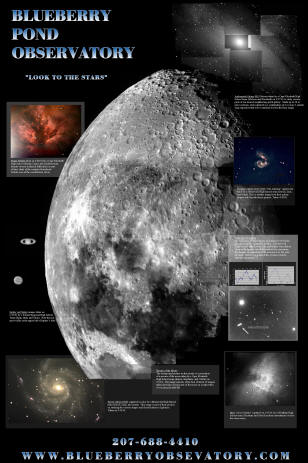-

-
Blueberry Pond Observatory
Hangs on Astronomy Projects offer even more challenge - great for science fairs and papers
-





BPO offers a huge range of hands on advanced Astronomy projects to further your understanding of our universe, and to improve anyone's science, math, engineering, and computer skills. Each project is customized to fit your experience levels in astronomy. There are projects for all age levels. Please email us with questions or suggestions for projects you are interested in.
Each project is customized based on your experience levels, and can be executed in several different ways. Eight hours or more are involved for most of these projects. You can do the project onsite here at BPO, or make arrangements for remote execution of projects at your home, classroom, or library. Each project has certain goals for learning and accomplishing the focus of the project, and uses images captured by and for you at the observatory. A fun time and challenge can be found for any group... individuals, library groups, scout troops, school groups K-12, college groups, classrooms, and more. See below for level assignments.
These projects are also great for science fairs, home schooling, and independent study programs.
Sample Projects available: ( novice, intermediate, advanced )
 Building Blocks of our galaxy and beyond:
Building Blocks of our galaxy and beyond:
 Moon Studies for all ages:
Moon Studies for all ages:
Capture mosaics of the moon and learn how to measure the size of features in your pictures, what math is involved to measure these features, and why the moon looks the way it does.
 Astrometry - discovering asteroids and comets:
Astrometry - discovering asteroids and comets:
 Asteroid light curves- photometry:
Asteroid light curves- photometry:
 Variable stars - photometry:
Variable stars - photometry:
|
|
 Hertz Russell Diagrams of star clusters:
Hertz Russell Diagrams of star clusters: |
|
 |
H-R Diagrams are a fundamental cornerstone of modern astronomy. These charts show the whole life cycles of stars over billions of years, and how a star transitions from one stage of its life cycle to another. Learn how to create your own H-R diagram and see the "herds" of stars fall into place for young newborn blue tinted stars, mellow middle aged stars, and ancient red hued stars. See for yourself how you can group stars based on their color and brightness alone, revealing so much more about their evolutionary patterns. On the left is an example of charting H-R data for M67 done here at BPO by Joan Chamberlain, compared against other studies of M67. |
|
|
|
 |
|
 Extra-Solar planet transits - observing
planets around other stars:
Extra-Solar planet transits - observing
planets around other stars: |
|
 |
One of the big new frontiers in astronomy going on right now is detecting and indirectly observing planets orbiting around other stars. The goal being to eventually learn how many other earth like planets may be out there in the universe... One of the most common ways to see evidence of a planet orbiting a far away star is to simply watch for a slight dimming of the star as a planet swoops in front of the star during its orbit. The planet blocks a tiny portion of the light during this "partial eclipse" of sorts, and can be observed for yourself using careful photometry methods. [ see asteroid and variable star photometry studies above ] This project explores how to help verify planets orbiting other stars by observing stars suspected of having transiting planets. Learn all the tricks of the trade, and apply them for yourself. |
 Moon
Crater and Mountain Heights measured by their shadows: Moon
Crater and Mountain Heights measured by their shadows: |
|
 |
Craters and Mountains on the moon cast very dramatic shadows along the "terminator line" where sunset or sunrise is taking place on the moon on a given day. These shadows can be measured in digital images, and the correct math will allow you to compute the height of the features casting these shadows. Join us and dive into this amazing way to understand just what you are seeing with your eyes when you peer at the dramatic surface of the moon. |